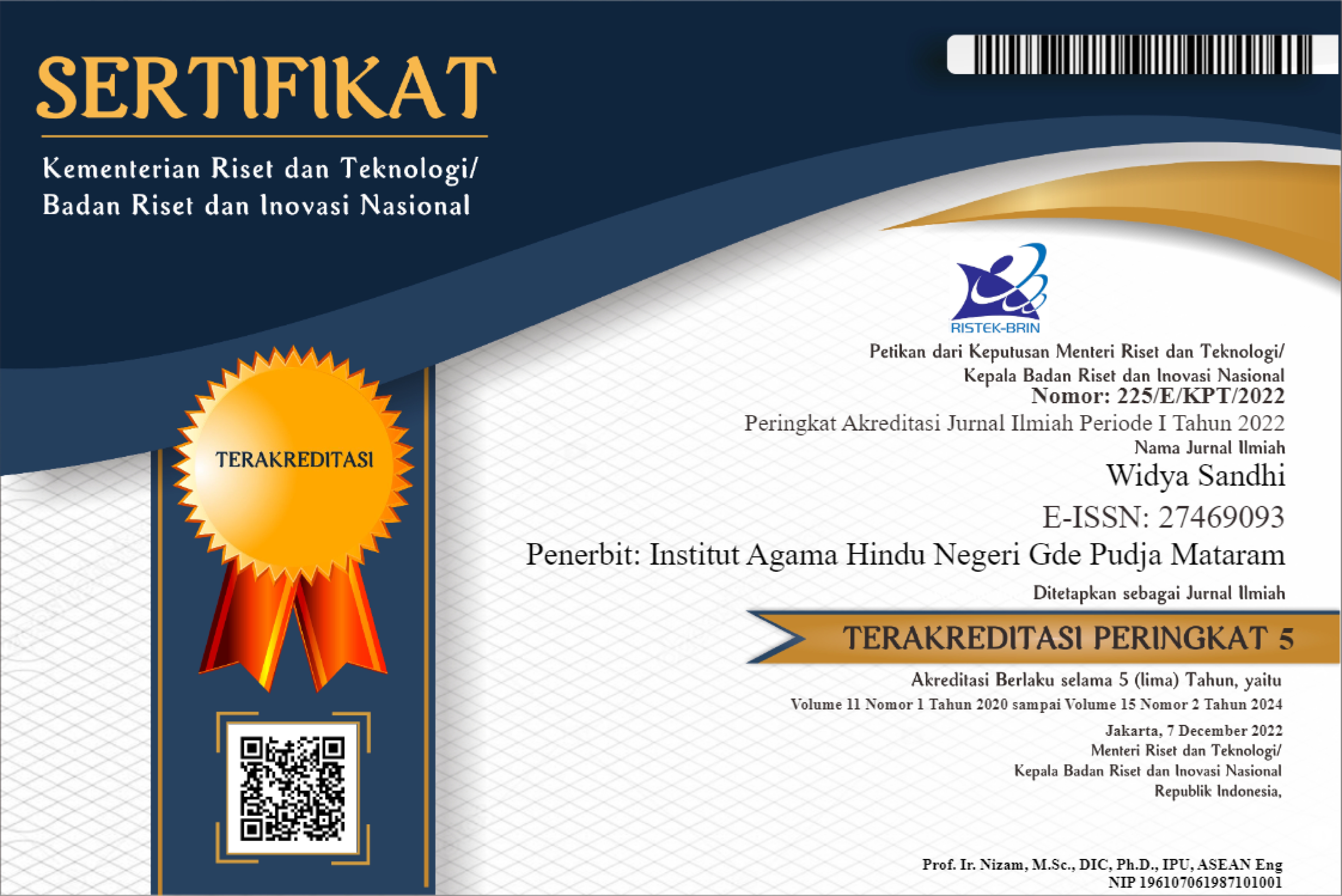Parekan Buduh Dalam Pementasan Drama Gong Bali (Perspektif Estetika Humor)
Abstract
The structural form of a gong drama performance is always associated with the musical accompaniment to the performance, namely percussion petegak, pepeson, pasiatan, and finally pamuput. Followed by the Prologue, which is a panyembrama or introductory words at the start of a drama play, then it starts with Pepeson which is a sign of the appearance of a person or several characters in starting scene by scene in each act. There are pepeson scenes for petangkilan, meseneng-senengan scenes, romance scenes, pasiatan scenes, and pamuput scenes. However, according to the sources who have explained above, the structure of the gong drama performance is uncertain depending on the story being told but still maintains the standard of Balinese gong drama.
The characteristics of the punakawan buduh in the Balinese gong drama performance can be divided into two characters, where there is a tough character which characterizes the human nature of being arrogant, arrogant, self-righteous and fierce. There are also soft characters that are inversely proportional to hard characters, soft characters emphasize human traits that are kind, full of empathy, intelligent, and not arrogant. These two characters symbolize different dualities or what is called rwa bhineda, traits that cannot be separated in human traits in general.
The aesthetic theory of humor contained in Punakawan Buduh is divided into three parts, the first is the theory of superiority, the second is the theory of incompatibility and the third is the theory of tension. However, during the performance, the Punakawan Buduh characters, without realizing it, were using this third theory when conveying the joke material. Because in general the Punakawan Buduh characters often practice on stage without knowing the theory of humor they are using, but each joke material already contains this theory of humor according to the situation that occurs during the performance of the Balinese gong drama
References
Bandem, I Made dan Fradarik Eugene de Boer. 2004. Kaja dan kelod, Tarian Bali dalam transisi. Yogyakarta: Badan Penerbit Institut Seni Indonesia, Yogyakarta.
Bandem, I Made dan Murgiyanto, Sal. 1996. Teater Daerah Indonesia. Yogyakarta: Kanisius.
Bandem, I Made. 1996. Evolusi Tari Bali. Yogyakarta: Kanisius.
Bandem, I Made dan Rembang, I Nyoman. 1976. Perkembangan Topeng Bali Dan sebagai Seni Pertunjukan. Denpasar: Proyek Penggalian, Pembinaan, Pengembangan Seni Klasik/Tradisional dan Kesenian Baru, Pemerintah Daerah Tingkat I Bali.
Balai Kajian Seni dan Desain Jurusan Seni dan Desain Fakultas Sastra Universitas Negeri Malang
Disertasi Sugita Universitas Hindu Indonesia (2016), Dinamika Seni Pertunjukan Drama Gong Di Kabupaten gianyar.
Education. Tersedia: http://www.uncg.edu/art/ courses/rwrice/360/AAprec. Htm [4 Maret 2006].
I Made Yudhabakti & I Wayan Watra. (2007). Filsafat Seni Sakral Dalam Kebudayaan Bali. Surabaya: Paramita. Cet.2015
Koentjaraningrat (1974), Kebudayaan Indonesia bersifat Universal
Mahendra & juni. (2020). Semiotika Punakawan & Hermeneutika Krsna.
Osborne, H. (1970). The Art of Appreciation. London: Oxford University Press.
Rice, R. W. (1997). Art Appreciation. (Online). In Art 360 Foundation of Art Education. Tersedia: http://www.uncg.edu/art/ courses/rwrice/360/AAprec. htm [4 Maret 2006].
Ratna (2010) penjelasan data primer dalam penelitian
Purnamawati (1984) dengan judul ”Drama Gong sebagai bentuk teater tradisional Berbahasa Bali
Rahardjo, M. (2011). Metode Pengumpulan Data Penelitian Kualitatif.
Soehardjo, A. J. (2005). Pendidikan Seni, dari Konsep sampai Program. Malang: Balai Kajian Seni dan Desain Jurusan Seni dan Desain Fakultas Sastra Universitas Negeri Malang
Sugita & Tilem (2018) karya tulis Inovasi Seni Pertunjukan Drama Gong pada Era Digital
Seramasara (2017) karya tulis Seni Pertunjukan Tradisional Bali Sebagai Warisan Zaman Bali Kuno
The Liang Gie (2004), Filsafat keindahan
Penelitian Semadi (2015) yang berjudul “keterpinggiran drama gong Wijayakusuma Abianbase Gianyar
Yaya Ruyatnasih, S.E. & Megawati, L (2018).pengantar Manajemen: teori, Fungsi dan kasus. Absolute Media
https://kumparan.com/berita-hari-ini/mengenal-punakawan-karakter-khas-pewayangan-jawa-1w1oP44xxW0
https://id.wikipedia.org/wiki/Drama_Gong
https://kbbi.web.id/seni
https://tamanbali.desa.id/

This work is licensed under a Creative Commons Attribution-NonCommercial-ShareAlike 4.0 International License.
Authors who publish with this journal agree to the following terms:
- Authors retain copyright and grant the journal right of first publication with the work simultaneously licensed under a Creative Commons Attribution-ShareAlike 4.0 International License. that allows others to share the work with an acknowledgment of the work's authorship and initial publication in this journal.
- Authors are able to enter into separate, additional contractual arrangements for the non-exclusive distribution of the journal's published version of the work (e.g., post it to an institutional repository or publish it in a book), with an acknowledgment of its initial publication in this journal.
- Authors are permitted and encouraged to post their work online (e.g., in institutional repositories or on their website) prior to and during the submission process, as it can lead to productive exchanges, as well as earlier and greater citation of published work (See The Effect of Open Access).






.jpg)




